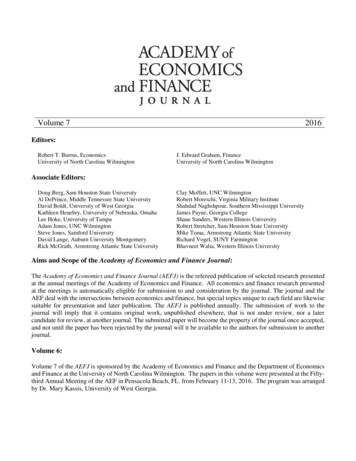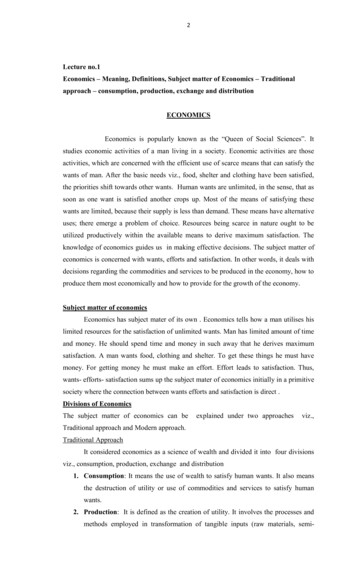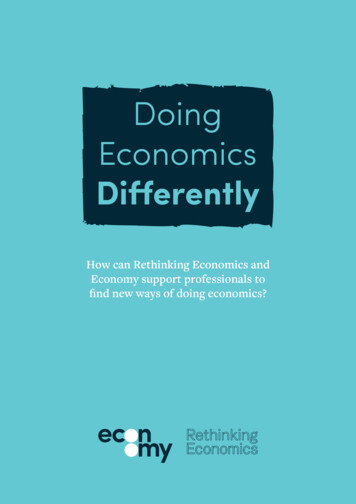
Transcription
Volume 72016Editors:Robert T. Burrus, EconomicsUniversity of North Carolina WilmingtonJ. Edward Graham, FinanceUniversity of North Carolina WilmingtonAssociate Editors:Doug Berg, Sam Houston State UniversityAl DePrince, Middle Tennessee State UniversityDavid Boldt, University of West GeorgiaKathleen Henebry, University of Nebraska, OmahaLee Hoke, University of TampaAdam Jones, UNC WilmingtonSteve Jones, Samford UniversityDavid Lange, Auburn University MontgomeryRick McGrath, Armstrong Atlantic State UniversityClay Moffett, UNC WilmingtonRobert Moreschi, Virginia Military InstituteShahdad Naghshpour, Southern Mississippi UniversityJames Payne, Georgia CollegeShane Sanders, Western Illinois UniversityRobert Stretcher, Sam Houston State UniversityMike Toma, Armstrong Atlantic State UniversityRichard Vogel, SUNY FarmingtonBhavneet Walia, Western Illinois UniversityAims and Scope of the Academy of Economics and Finance Journal:The Academy of Economics and Finance Journal (AEFJ) is the refereed publication of selected research presentedat the annual meetings of the Academy of Economics and Finance. All economics and finance research presentedat the meetings is automatically eligible for submission to and consideration by the journal. The journal and theAEF deal with the intersections between economics and finance, but special topics unique to each field are likewisesuitable for presentation and later publication. The AEFJ is published annually. The submission of work to thejournal will imply that it contains original work, unpublished elsewhere, that is not under review, nor a latercandidate for review, at another journal. The submitted paper will become the property of the journal once accepted,and not until the paper has been rejected by the journal will it be available to the authors for submission to anotherjournal.Volume 6:Volume 7 of the AEFJ is sponsored by the Academy of Economics and Finance and the Department of Economicsand Finance at the University of North Carolina Wilmington. The papers in this volume were presented at the Fiftythird Annual Meeting of the AEF in Pensacola Beach, FL. from February 11-13, 2016. The program was arrangedby Dr. Mary Kassis, University of West Georgia.
Volume 7Table of Contents2016Peer-to-peer Equity Investments in Germany. A Note on Successful CompanyCharacteristicsParthepan Balasubramaniam, Florian Kiesel, and Dirk Schiereck1Currency ETF Tracking ErrorRobert B. Burney9The Effect of U.S. Official Reserve Flows on the Japanese Yen-U.S. Dollar ExchangeRate in a Business CyclePablo A. Garcia-Fuentes and Yoshi Fukasawa17Economic Growth and Revitalization on Long Island: the Role of the RecreationalFishing and Marine EconomySheng Li, Richard Vogel, and Nanda Viswanathan29Natural Disasters in Latin America: Disaster Type and the Urban-Rural Income GapMadeline Messick35Budgetary Lags in NigeriaVincent Nwani47Managerial Decisions and Player Impact on the Difference between Actual and ExpectedWins in Major League BaseballRodney J. Paul, Greg Ackerman, Matt Filippi, and Jeremy Losak57Comparative Return Distributions: Strangles versus StraddlesGlenn Pettengill and Sridhar Sundaram63Towards A Global Framework for Impact InvestingMarc Sardy and Richard Lewin73Another Clue in the Market Efficiency PuzzleKaren Sherrill81i
Optimizing Strategies for Monopoly: The Mega Edition Using Genetic Algorithms andSimulationsShree Raj Shrestha, Daniel S. Myers, and Richard A. Lewin, Rollins College187How Retirees Prioritize Socializing, Leisure And Religiosity - A Research Based Study ForPlanners.Aman Sunder, Swarn Chatterjee, Lance Palmer, and Joseph W. Goetz99Early Child Health Intervention and Subsequent Academic AchievementBhavneet WaliaCopyright 2016 by the Academy of Economics and FinanceAll Rights Reservedii107
Academy of Economics and Finance Journal, Volume 7Peer-to-Peer Equity Investments in Germany. A Note onSuccessful Company CharacteristicsParthepan Balasubramaniam, Florian Kiesel, and Dirk Schiereck, Technische UniversitaetDarmstadt, GermanyAbstractPeer-to-peer investing is often considered to be a mass alternative to business angel investing. This paper introduces peerto-peer investing as a new financing instrument for start-ups in the traditionally bank-based financial system of Germany andidentifies characteristics that influence the funding success of peer-to-peer investing projects. Based on a comprehensive pictureof the peer-to-peer investing platforms in Germany, we analyze 126 funded projects from the three largest German platformsSeedmatch, Companisto and Innovestment. Our results show that larger projects are more successful in funding while thesmallest platform is less promising.IntroductionMoenninghoff and Wieandt (2013) illustrate that the peer-to-peer equity investing markets in Europe are less developedthan the peer-to-peer lending markets despite the emergence of the first investing platforms in 2006. Overall, peer-to-peerequity investing is still a hardly used financing source and by far smaller than the according hype in the media might expect.The market volume reached only a low-double digit amount early this decade and appears tiny in absolute terms compared tothe overall investment volume managed globally by private equity and venture capital funds. But the compound monthly growthrate of 10% since the beginning of 2010 indicates the rapid growth of this innovative form of financial intermediation over thelast years (Moenninghoff and Wieandt, 2013, p. 6-7).In Germany, not only the IPO and equity capital markets are comparably small compared to the overall economic strengthof its economy, but also the peer-to-peer equity investing markets. One often claimed reason for this weakness lies in the lessdeveloped German venture capital (VC) industry which might restrict funding sources for young growth companies. With theupcoming of electronic peer-to-peer financing platforms, there are new alternative funding sources which address the VC gap.However, if a leading economy is confronted with a less developed VC community, it is unclear how this institutionalbackground allows peer-to-peer investing platforms to generate sufficient capital supply for funding purposes of youngventures. Here our analyses start.We take a focus on peer-to-peer investing platforms in Germany which were established since 2010. The market is stillhardly analyzed by empirical research on firm characteristics that can explain the success of funding campaigns on theseplatforms. Our results allow a deeper understanding of the effectiveness of peer-to-peer investing as an alternative financingsource for start-ups, and to analyze the success factors of German peer-to-peer investment projects.The rest of the paper is organized as follows: The following chapter provides a more comprehensive description of peerto-peer investing, in particular the German peer-to-peer investing market. We then analyze successful peer-to-peer investingprojects empirically, examining the dependence of certain attributes. Finally, we briefly summarize our main results and offerour conclusion.The German Peer-to-Peer Investing Platforms and InstrumentsIn Germany, peer-to-peer investing and trading platforms are highly regulated in the case of pure equity financing.Platforms, which allow equity financing via stock offerings, need a bank license for their businesses. Consequently, in anattempt to avoid strict regulation, most platforms in Germany decided to offer only hybrid financing instruments which areequity-like but not that strictly regulated. As a result, the German peer-to-peer investing market is dominated by platformswhich claim to place equity but really bring together sponsors and founders/entrepreneurs for hardly fungible hybrid assets.These assets include a variety of configuration options. They all have in common being subordinated to traditional debt capitaland primary to pure equity in terms of repayment. The existing flexibility in these contracts is the main advantage of thesesecurity designs which may also explain that in practice the peer-to-peer investing in Germany exists almost exclusively inhybrid forms of financing, where these are limited to silent partnerships, participation rights and subordinated shareholderloans, and only in very few transactions as stock equity investments. Table 1 gives an overview of the four forms of financingand security designs.1
Academy of Economics and Finance Journal, Volume 7Table 1: Characteristics of the four forms of per-to-peer investing financingTypeLiabilityProfit sharingLoss sharingShare in the assetsShare in theliquidation proceedsVoting rightsControl oYesYes Yes Yes Yes Yes Yes SilentPartnershipMezzanineNo Yes Yes Yes (atypical)ParticipationRightMezzanineNo Yes Yes No Yes Optional (atypical)Yes Yes (above 100,000EUR)SubordinatedShareholder LoanMezzanineNo Yes No No OptionalYes No No No Yes Yes No The peer-to-peer investing market is increasingly growing in Germany. It started from a very low base in 2011 at a volumeof 450,000 EUR, with enormous growth in 2013 to a financing volume of 15 million EUR, which is an increase of around 250per cent over 2012. The first half of 2014 amounted to 8.3 million EUR. Table 2 provides an overview of all German peer-topeer investments which operate from Germany. Based on these figures, it can be assumed that the platforms with the highestfunding volumes provide the best infrastructure and represent a benchmark for the industry. In particular, Seedmatch,Companisto and Innovestment, meet these selection criteria. Therefore, our further analysis focuses on the most successfulplatforms in Germany. Seedmatch went online on October 14, 2009, and presented in August 2011 their first financedcompanies. It had 85 successful financing projects and 25.7 million EUR in financing volume by the end of 2015. This platformonly supports mezzanine capital in the form of a subordinated shareholder loan. All financing investments before November29, 2012, were originally financed by another form of mezzanine capital – the typical silent partnership.Table 2: Characteristics of the most active German peer-to-peer investing platforms (December 31, Completedfunding volumes25.7 mn EURInnovestmentCompanisto2011201230552.6 mn EUR26.4 mn EURDeutscheMikroinvestFundsters20125018.2 mn EUR2012101 mn EURBankless24201280.6 mn EURUnited Equity201240.1 mn EURBergfürstDirect Startups201120122Not stated3.8 mn EURNot statedFinancing typesSubordinatedshareholder loansSilent partnershipSubordinatedshareholder loansVariableIndirect ights and silentpartnershipVariableNot statedMinimuminvestment250 EURHolding period5 years500 EUR5 EURNo specific8 years250 EURVariable1 EUR5 years100 EUR5 to 7 years100 EUR5 to 10 years10 EUR2.50 – 50EURNo specificVariableCompanisto had 55 successful fundings and 26.4 million EUR funding volume until the end of 2015. Since the beginningof 2013, Companisto only supports mezzanine capital in the form of a subordinated shareholder loan. All financing before theyear 2013 was originally financed by another form of mezzanine capital – the atypical silent partnership. Innovestment had 30successful fundings and 2.6 million EUR financing volume by the end of 2015. This platform only supported mezzanine capitalin the form of an atypical silent partnership until second half of 2015. The new participation model is in the form of asubordinated shareholder loan in a special purpose vehicle, which then invests the whole amount as an equity investment into2
Academy of Economics and Finance Journal, Volume 7the start-up. For the analysis, only the investment types until end of 2013 were considered. Innovestment started almost at thesame time as Seedmatch and first established itself as a number two in the crowdfunding market, but without growth as that ofthe market leader Seedmatch. Innovestment obviously has not succeeded in inspiring start-ups and investors in the same wayas Seedmatch and Companisto. A particular disadvantage is sticking to the 100,000 EUR limit in relation to the maximumfunding volume for the start-ups, and the fact that Companisto for a long time kept a minimum investment of 1,000 EUR forinvestors. Meanwhile, Innovestment has lowered the minimum amount for some projects to 500 EUR. Table 3 provides anoverview of the characteristics of the three peer-to-peer investing platforms.Table 3: Characteristics of the investment platforms Seedmatch, Companisto and 011B2C, Cleantech,Social BusinessSubordinated shareholder loans(silent partnership until 2013)Unlimited250 EURCompanisto2012Innovestment2011No limitationsNo limitationsSubordinated shareholder loans(silent partnership until 2013)Unlimited5 EURAtypical silentpartnership100,00 EUR500 EURNormally 5 yearsNormally 8 yearsNoneConditions forinvestorsShare on profit increase inenterprise valueShare on profit increase inenterprise valueFees for start-ups5 to 10 % agency fee10 % agency feeInvestment typesFunding limitMinimum amountMinimum holdingperiodShare on profit increase in enterprisevalue1% Emission fee 5 % agency feeEmpirical AnalysisWe collected all peer-to-peer investing projects at Seedmatch, Innovestment, and Companisto starting with the firstfinanced projects in 2011 up to the most current finalized projects in 2014. Peer-to-peer investing projects still in the fundraisingprocess were removed due to the limited comparability of completed and uncompleted projects. Starting with 144 peer-to-peerinvesting projects initially, 126 remain in the sample. Table 4 presents the peer-to-peer investing projects, the respectiveplatform and the key statistics of the project. The average enterprise value is about 2.25 million EUR and the average fundingthreshold is about 240,000 EUR, which is only around 10% of the enterprise value. The mean number of funding investors foreach project is approximately 324, the mean funding for each investor is therefore around 744 Euro per investment project. Theminimum holding period for an investment is 5.7 years in average, if a holding period is required.In order to analyze the determinants of successful peer-to-peer investing we focus on variables from prior studies (e.g.Agrawal et al., 2015; Hornuf and Schwienbacher, 2014) which engage with similar analyses and mostly use linear regressionmodels in the following form:𝑣𝑖 𝛼𝑖 𝛽1 𝑥1𝑖 𝛽𝑚 𝑥𝑚𝑖 𝑢𝑖 ,(1)where i 1, ., N are the peer-to-peer investing projects, 𝑣𝑖 is the natural logarithm of the funds raised in the first modeland funds raised over funding limit, in the second model. These two variables define our measure of funding success. 𝛼𝑖 is thecompany-specific regression constant, 𝑥𝑗𝑖 (j 1, ., m) are the explanatory characteristics and 𝑢𝑖 denotes the correspondingerror terms. Standard errors are corrected for heteroskedasticity and as a robustness of our results we include firm and yearfixed effects in our model. Equation (1) specifies without further restriction an ordinary least square (OLS) regression model.3
Academy of Economics and Finance Journal, Volume 7Table 4: Descriptive statistics of the three platformsYearPlatform2011 Total- Innovestment- Seedmatch2012 Total- Companisto- Innovestment- Seedmatch2013 Total- Companisto- Innovestment- Seedmatch2014 Total- Companisto- Innovestment- SeedmatchTotalInvestments Sum 8,366,25030,357,532Mean Mean No. ofFirm Size 755,167422.112,251,241323.88As a measure for the peer-to-peer funding success, two variables will be analyzed independently. The first variableTOTAL INVESTMENT is defined as the natural logarithm of the total funds raised in EUR. However, the upper limit on whicha peer-to-peer investing campaign is stopped prevents free market forces from developing a price and this could influence theanalysis. Therefore, we additionally analyze the variable SUCCESS RATIO, which is the ratio of funds raised over the fundinglimit. Other variables, such as the time it takes to reach the funding threshold or limit, might also be a good measurement.However, this data is not publicly available on the crowdinvesting plat-form, and therefore not included in this analysis.The number of founders is relevant according to findings of Evers (2012) due to the fact that the success rate of start-uppeer-to-peer investing is higher when a team initiates a project rather than an individual. The variable NO FOUNDERS is aninteger and was retrieved from the description on the company’s peer-to-peer investing platform. The enterprise value waschosen as a parameter, because it determines the company’s capital requirements and the share that an investor gets in acompany. The variable ENTER VALUE is the natural logarithm of the enterprise value in EUR that was announced on thepeer-to-peer investing platform prior to the start of the fundraising process.The stage in the corporate lifecycle can also be another important part of an investor’s decision, whether to invest in acompany. Our models consist of two dummy variables STARTUP and EXPANSION. The company specific information wasretrieved from the online platforms. We also include a dummy to control for the legal form of the firm that needs new capital.Some legal forms have a higher capital reserve than others; for example, a Gesellschaft mit beschraenkter Haftung (GmbH),which is similar to a private limited company, has a higher capital reserve than an entrepreneurial company, namelyUnternehmergesellschaft (UG). The legal forms represented in our sample are only GmbH and UG. This characteristic iscaptured by the dummy variable LF GMBH that is defined as 1, if the legal form is a GmbH, otherwise the variable is 0. Interms of experience, the age at the time of the peer-to-peer investing campaign of the start-up might determine the successfulfunding. The variable AGE is retrieved from the peer-to-peer investing platforms and calculated as the deviation between theyear of the establishment and the year of the peer-to-peer investing.In addition, the actual financing instrument may a factor which is important for a successful peer-to-peer investing.Different types of financing instruments have different risks as well as payback rates. The type of financing instrument comesalong with different benefits as explained in the prior section. This characteristic is captured in the variable SILENT defined as1, if the investment is financed via a silent partnership, and 0 for the type of subordinated shareholder loans. The financinginstrument participation right was not used in our data sample. Finally, we control for platform effects, expecting that thesmallest platform is less attractive, because of its limited visibility. COMPANISTO and INNOVESTMENT each defined as 1,if the firm raising money through peer-to-peer investing used the platform Companisto or Innovestment as their platform.Table 5 presents the descriptive statistics with the variables used in the subsequent analysis. Due to missing observations,the number of observations dropped from 126 to 101. Two additional facts can be read from the table. First, the average teamsize is two and the maturity of the companies is 1.6 years in average. In contrast, the holding period with 5.7 years in averageseems to be long. It shows that investors are willing to participate in companies with less than two years maturity even thoughthey get a small share in the company and have to hold this investment for at least five years. The top three industries in oursample are information and communication industry (NACE Code J) with 32.3 per cent, wholesale and retail trade (NACE4
Academy of Economics and Finance Journal, Volume 7Code G) with 23.6 per cent and manufacturing industry (NACE Code C) with 22.8 per cent. The common legal form forcompanies raising money through peer-to-peer investing is a GmbH with 86 per cent of the whole sample.Table 5: Characteristics of crowdfunded projects in Germany: summary statistics of the control variablesVariableNO FOUNDERSENTER VALUESTARTUPEXPANSIONLF 300.430.420.50Median Min2.001.0014.32 0Before further analyzing those variables with a regression model, a simple correlation analysis is performed. In Table 6,the correlation between each independent variable can be seen. Most of the independent variables are not correlated with eachother. We only find some correlations between variables. As expected, the firm size is positively correlated with the expansiondummy, the age of the company, and the legal form of the company. Larger firms mostly have the legal form of GmbH, arelonger in the market, and are in the expansion phase. In addition, we find that the variable of COMPANISTO has a negativecorrelation to the firm size, indicating that larger firms do not use this platform in particular. In order to avoid multicollinearityin our OLS regression analysis, we analyze the variance inflation factors (VIF) to quantify the severity of multicollinearitybetween each variable in the analysis.Table 6: Coefficient matrixVariable1234567891 FOUNDERS1.0002 VALUE-0.194* 1.0003 START UP0.1180.1161.0004 EXPANSION-0.156 0.217**-0.312*** 1.000**5 LEGAL FORM-0.043 0.2550.241**0.0811.000***6 AGE-0.153 0.4570.1070.350*** 0.273*** 1.0007 COMPANISTO0.390*** -0.268*** 0.185*-0.021 0.010-0.0901.0008 INNOVESTMENT 0.006-0.185*0.0210.219** 0.081-0.012-0.1321.0009 SILENT0.002-0.400*** -0.315*** -0.049 -0.230** -0.281*** -0.179*0.267*** 1.000This table provides the correlation coefficient matrix of main independent variables. The sample includes 126 crowdinvestingprojects from the three peer-to-peer investing platforms Innovestment, Seedmatch, and Companisto. ***, **, * denotesstatistical significance at the 1%, 5%, and 10% level, respectively.Table 7 shows the results for the total funds raised. The firm value has a highly significant impact on the total funds raised.That is not surprising, since larger companies require higher funding. All investments before the beginning of 2013 wereoriginally restricted to a maximum of 100,000 EUR by the previously practiced atypical silent partnership. The regressionanalysis shows that this type of partnership also results in lower funds. Contrary to expectations, the number of founders, thestage in the corporate lifecycle, legal form and the age of the company do not appear to determine the sum of total funds raised,as their coefficients generally lack significance. In addition, we do not find any significant differences for the platforms. Addingyear and industry fixed effects improves the overall explanatory power of the model minimally.5
Academy of Economics and Finance Journal, Volume 7Table 7: Results of the regression analysis for total funds raisedSampleModel 1Model 2Coefficient t-Value **5.2951.7790.668***5.3612.099START 0.4741.560-0.017-0.0521.732LEGAL -0.010-0.0281.720INNOVESTMENT 01.544-0.655***-3.5922.524Industry EffectsNOYESYear EffectsNOYESn101101Adj. R251.47%51.95%F-value20.99***12.65***This table shows the results of the OLS regression for the 101 investing projects on Seedmatch, Innovestment, andCompanisto. The dependent variable is the natural logarithm of the total funds raised in EUR. Standard errors are correctedfor heteroskedasticity and associated t-statistics are given. ***, **, * denotes statistical significance at the 1%, 5%, and 10%level, respectively.A peer-to-peer investing project is only assessed as successfully funded if at least the predefined threshold set by the firm,which wants to raise money, has been reached. Furthermore, the greater the ratio of funds raised over the funding limit, themore successful is the funding itself. Table 8 provides the regression analysis with the success ratio of investments as thedependent variable.We again find that the company size influences, as the coefficient for VALUE ceases to be significant. Larger firms areable to raise funds over the announced funding limit. This may indicate that larger firms have a smaller probability to defaultand investors rely more heavily on these firms. This is nevertheless somewhat surprising as even larger start-ups still do nothave an established business model, and therefore the firm value is difficult to predict precisely. Moreover, the firm valueannounced on the platform is a subjective estimation of the firm owners and therefore not free of potential biases. In addition,we find that the success ratio is smaller for firms using the platform of Innovestment. Innovestment is the smallest of the threeplatforms in our sample. 28 of the 126 funding projects in our investigation are raised with Innovestment with an averagefunding of 86,279 EUR. The mean funding of Companisto and Seedmatch combined is 254,507 EUR. This result suggests thatlarger platforms increase the probability of a successful funding. For a successful funding, the financing instrument matters aswell. The variable of silent partnership is highly significant and positive, indicating that the successful funding increases forprojects offering a silent partnership. This may also be explained by the limitations of the maximum funding to a limit of100,000 EUR. This supports our prior results of the total funds raised. In addition, industry and year fixed effects slightlyimprove the overall explanatory power of the model.Overall, our results indicate that the company size has a strong positive influence on the funds raised and the success ofthe investing projects. In addition, we find that the platform has at least a weak significant influence on the success of funding.Platforms with larger quantity of large funding projects determine the success of funding in a similar manner than thedeterminants of the firms raising capital.6
Academy of Economics and Finance Journal, Volume 7Table 8: Results of the regression analysis for the success ratio of investmentSampleModel 1Model 2Coeffici t-Value .060*1.8731.7790.076**2.2622.099START 2701.5600.0670.7241.732LEGAL -0.028-0.5071.720INNOVESTMENT-0.093** 0.0421.317-0.038-0.4891.541SILENT0.142*** 0.0391.5440.170***3.1362.524Industry EffectsNOYESYear EffectsNOYESn101101Adj. R26.57%12.92%F-value3.86***3.29***This table shows the results of the OLS regression for the 101 investing projects on Seedmatch, Innovestment, and Companisto.The dependent variable is the ratio of funds raised over the funding limit. Standard errors are corrected for heteroskedasticityand associated t-statistics are given. ***, **, * denotes statistical significance at the 1%, 5%, and 10% level, respectively.Summary and ConclusionPeer-to-peer investing is going to become a popular method of financing start-ups and new business ideas. We introducepeer-to-peer investing as a new financing instrument for start-ups in the traditionally bank-based financial system of Germanyand identify characteristics which influence the funding success of peer-to-peer investing projects. Based on a comprehensivepicture of the peer-to-peer investing platforms in Germany, we analyze 126 funded projects from the three largest Germanplatforms Seedmatch, Companisto and Innovestment. Our results show that larger projects are more successful in funding whilethe smallest platform Innovestment offers a less promising service.ReferencesAgrawal, Ajay, Christian Catalini, and Avi Goldfarb. 2015. “Crowdfunding: Geography, social networks, and the timing ofinvestment decisions.” Journal of Economics & Management Strategy, 24(2): 253-274.Evers, Mart, Carlos Lourenço, and Paul Beije. 2012. “Main drivers of crowdfunding success: a conceptual framework andempirical analysis.” Erasmus Universiteit.Hornuf, Lars, and Armin Schwienbacher . 2014. “The Emergence of Crowdinvesting in Europe.” Available at SSRN2481994.Moenninghoff, Sebastian C., and Axel Wieandt. 2013. “The future of peer-to-peer finance.” Zeitschrift fürbetriebswirtschaftliche Forschung, 65: 466-487.7
Academy of Economics and Finance Journal, Volume 7Currency ETF Tracking ErrorRobert B. Burney, Coastal Carolina UniversityAbstractThe emergence of currency exchange traded funds (ETFs) has provided an alternative vehicle for both speculation andhedging in the currency markets. Because currency ETFs trade like equities and have no relevant expiration date, they representan intriguing alternative for managing certain types of foreign exchange risk. However, how well a particular currency ETFtracks the associated currency is importantOne of the most common metrics for ETF performance is tracking error. This metric, along with tracking difference hasbeen used extensively in many settings to describe ETF performance. However, to date a relatively limited amount of researchhas addressed these same issues for currency ETF specifically. This paper examines the trac
Peer-to-peer investing is often considered to be a mass alternative to business angel investing. This paper introduces peer-to-peer investing as a new financing instrument for start-ups in the traditionally bank-based financial system of Germany and identifies characteristics that influence the funding success of peer-to-peer investing projects .











